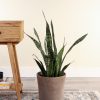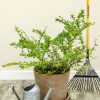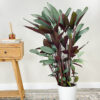Description
The Snake Plant with a Wilder SideThe Sansevieria Zeylanica, often called bowstring hemp, is an evergreen perennial plant. It is native to Southeast Asia and can also be found in tropical West Africa. It is particularly common in India and Sri Lanka and is often found growing in rocky areas.A unique characteristic about it is that it is a flowering plant that does not bloom more often than not. It is a hardy, almost indestructible plant with silver and green stripes and pointed tips. It can grow up to 3 feet tall on average.Other popular Sansevieria varieties include the Sansevieria trifasciata ‘Laurentii’ and the Sansevieria Whitney.Caring for your Sansevieria Zeylanica Snake PlantThis plant fares well both indoors and outdoors, with a few minor variations.LightingInside, a nice sunny area is the best option, but indirect light will suffice as well. Lower light exposure typically results in darker colors of the plant. On the other hand, outdoors, the plant can and will tolerate direct sunlight. However, you should note that intense or scorching sun can cause the leaves to yellow at the edges. In general, those grown outdoors tend to be a lighter green.WateringWhile the bowstring hemp can be drought-tolerant, it is important to water adequately during the peak growing months of summer and spring. Additionally, half-strength fertilizer is recommended every three weeks during summer.SoilBecause they can be prone to rot, choosing well-draining soil is essential for the longevity of your plant. While your plant should be able to adapt to a wide variety of potting soils, so long as they’re well-draining, a well-draining sandy loam is typically best for this plant.Pests, Diseases, and Common IssuesThe bowstring hemp is susceptible to mealybugs and spider mites. These pests drink the juices found within the plant’s leaves, negatively affecting the plant’s appearance. You can treat both of these pests with a bit of insecticidal soap and neem oil. For small mealybug infestations, an alcohol-dipped cotton swab will suffice.Bowstring hemps are sensitive to overwatering. An overwatered bowstring hemp can develop root rot. Root rot is easily preventable with the right amount of watering and proper drainage.The plant can, at times, have too many leaves falling over. This is usually caused by too much fertilizer. The bowstring hemp is typically a slow to moderate grower, but too much fertilizer can accelerate growth, leaving the plant unable to support the leaves’ weight.Pruning your Zeylanica Snake PlantBowstring hemps do not require much pruning. Damaged or dead leaves are rare with this plant, but they can be pruned away should it occur. If only the tip is damaged, you can easily salvage the rest of the leaf.If the damage has spread the entirety of the leaf, remove it at the soil level. Occasionally, a leaf or two may fall over in a crowded plant. These leaves can be cut with pruning shears and propagated as cuttings.PropagationBowstring hemp plants grow best from propagation, and leaf-cutting is the common method ofpropagation for these plants. You should cut 2 to 3 inch long sections from healthy leaves to get started. The cuttings will need to dry for a few hours before planting in a damp potting mix.Potting and RepottingBowstring hemp plants should be repotted when the plant is crowded in its current pot. This could range from 2 to 5 years. This may also be a time to consider dividing the plant. Repotting is best from late winter to early spring.Is the Sansevieria Zeylanica Snake Plant Pet Friendly?This plant is toxic to pets. Keep out of reach of pets that like to much on your plants.





